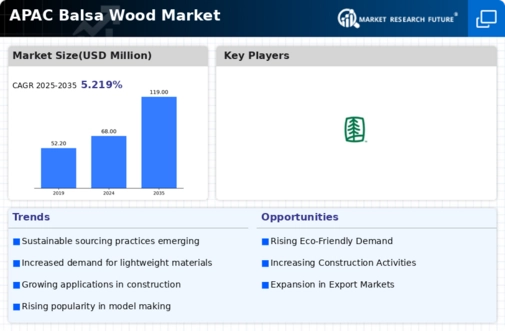The APAC Balsa Wood Market is characterized by a dynamic competitive landscape driven by the increasing demand for lightweight and sustainable materials in various industries, including construction, crafts, and model-making. As balsa wood is known for its buoyancy, elasticity, and ease of use, it has gained traction among manufacturers and consumers alike. The competitive insights within this market are shaped by the presence of several key players, each striving to enhance their market share through innovations in product offerings, strategic partnerships, and expansion of distribution networks.
The continuous focus on sustainability and eco-friendly sourcing of balsa wood is further influencing the competitive strategies adopted by companies operating in this region, reflecting the growing awareness and commitment towards environmental conservation among consumers.Tengu Moku Co. Ltd stands out in the APAC Balsa Wood Market due to its robust reputation for quality and reliability. The company has established a strong market presence by consistently delivering high-grade balsa wood products that meet the varied needs of industries such as model-making and aerospace.
Known for its commitment to sustainable practices, Tengu Moku Co Ltd emphasizes sourcing its balsa wood through responsible forestry methods, which enhances its brand appeal in a region increasingly concerned with environmental issues. The company’s strengths lie in its innovative manufacturing techniques, which allow for the production of lightweight materials that do not compromise on strength or durability.
Furthermore, Tengu Moku Co Ltd has cultivated a loyal customer base, benefiting from strong relationships with key distributors across the APAC region, which fosters extensive market penetration and visibility.UFP Industries has made significant strides in the APAC Balsa Wood Market by leveraging its extensive experience and diversified product portfolio. The company offers a variety of balsa wood products that cater to both industrial applications and consumer markets, including premium-grade sheets and cutting services tailored to specific customer requirements.
UFP Industries has built a notable market presence not only through its high-quality offerings but also by maintaining strategic partnerships and exploring mergers and acquisitions that foster regional growth and innovation. Its strengths lie in its ability to adapt to changing market dynamics, coupled with a comprehensive distribution network that ensures consistent product availability. By investing in advanced production technologies and sustainability initiatives, UFP Industries continues to enhance its competitive edge, solidifying its position as a prominent player in the APAC Balsa Wood Market.












Leave a Comment